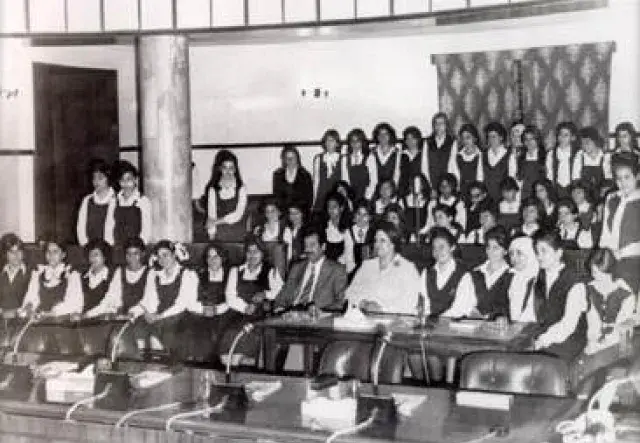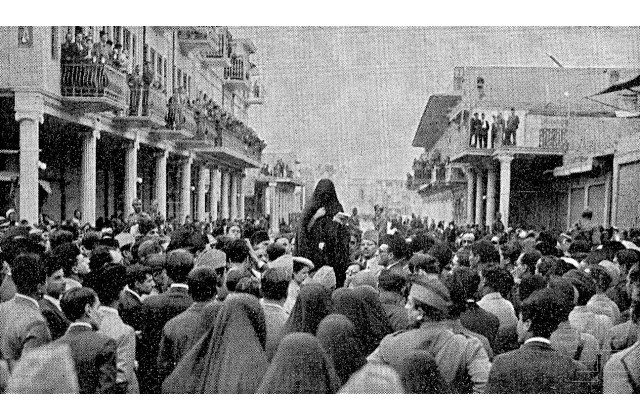لە کۆماری سۆسیالیستی مەبەستدارەوە بۆ دیکتاتۆری سەددام (١٩٦٨ - ١٩٧٩)

لەگەڵ کودەتاکەی شۆڕشی ١٧ی تەمووز، پارتی سۆسیالیستی عێراق دەسەڵاتی گرتە دەست و ئەحمەد حەسەن بەکریش وەک سەرۆک کۆماری عێراق. دەستووری نوێ داوای ڕێبازی سۆسیالیستی دەکرد. لە کاتێکدا کە مێژووی یەکجار سادەکرد، بەڵام پارتی بەعس بە کەڵک وەرگرتن لە تەلەفزیۆن و ڕادیۆ هانی عەرەب، کورد، تورکمان و کەمینەکانی تری دا کە خۆیان وەک "نەوەی شانشینە سامیەکانی میزۆپۆتامیا" سەیر بکەن، ئەمەش هەستی یەکێتی نەتەوەیی پەروەردە کرد. لە دوای شەڕی یەکەمی عێراق و کورد، حکومەتی عێراق و سەرۆکی پارتی دیموکراتی کوردستان مستەفا بارزانی لە ١١ی ئازاری ١٩٧٠ ڕێککەوتنی ئۆتۆنۆمی عێراق-کوردیان واژۆ کرد. لە ٢١ی ئایاری ١٩٧٠ یاسای چاکسازی کشتوکاڵی، خاوەندارێتی زەوی تایبەتی سنووردار کرد بۆ زۆرترین بڕی کە ٢٠٠٠ دۆنم زەوی ئاودێری نەکراو و ٦٠٠ دۆنم زەوی ئاودێری بوو. ئەوەشی کە ماوە بە نیشتمانی کرا و بەسەر جووتیاراندا دابەشکرایەوە. لە ناوەڕاستی حەفتاکانی سەدەی ڕابردوودا ٧٢٪ی زەوی وڵاتەکە بۆ نزیکەی ٢٥٠,٠٠٠ جووتیار تەرخانکرا. چاکسازییە زیاترەکانی حەفتاکانی سەدەی ڕابردوودا قەبارەی خاوەندارییەتی زەویەکانی کەمکردەوە، ئەمەش بووە هۆی زەوتکردنی زەوییە گەورەکان، لەوانەش زەوییەکانی خێڵە کوردەکان. لە کاتێکدا حکومەت بانگەشەی ئەوەی دەکرد کە نزیکەی ٢ ملیۆن هێکتار زەوی دابەشکردووەتەوە، سەرچاوە سەربەخۆکان ئەم ژمارانەیان بە زیادەڕەوی زانیوە، کە زەوییەکی زۆر بەیار کەوتووە و کەمیی هێزی کاریش پەرەی سەندووە.
لە ٤ی ئازاری ١٩٦٩ فیدراسیۆنی گشتی ژنانی عێراق (GFIW) کە لەلایەن دەوڵەتەوە پارەدار دەکرا، دامەزرا. کتێبی نوێی قوتابخانە نووسرا، فیلم بەرهەم هێنرا، فێستیڤاڵە ڕۆشنبیرییەکانی وەک فێستیڤاڵی بەهاری موسڵ (١٩٦٩) و فێستیڤاڵی ئەلواسیتی بۆ هونەرە جوانەکان (١٩٧٢) دەستیپێکرد. لە ساڵی ١٩٧٤ یەکەمین بینالی عەرەبی لە بەغدا بەڕێوەچوو. پارتی بەعس بەرنامەیەکی کۆمەڵایەتی بەرفراوانی جێبەجێ کرد کە بریتی بوو لە: خۆراکی پاڵپشتیکراو، دابینکردنی وزە و ئاوی گونجاو، فراوانکردنی سیستەمی پەروەردە و تەندروستی.
حیزبی بەعس بەهۆی ڕێبازی سۆسیالیستی سەرەتاییەوە، پەیوەندی نزیکی لەگەڵ کۆمەڵگای سۆسیالیست، بەتایبەتی چین و یەکێتی سۆڤیەت دامەزراند. لە ٤ی تەمموزی ١٩٦٩ ڕێککەوتننامەی هاوکاری ئابووری و تەکنیکی و لە ٢٣ی تەمموزی ١٩٦٩ پرۆتۆکۆڵی هاوکاری بۆ پەرەپێدانی هاوبەشی کێڵگەی نەوتی باکووری ڕومەیلا و دروستکردنی کەناڵەکان لە باشووری عێراق واژۆکرا. لە بەرواری ١ی حوزەیرانی ١٩٧٢ کۆمپانیای نەوتی عێراقی (IPC) بە نیشتمانی کرا. لە ساڵی ١٩٦٨ عێراق نزیکەی ٦٠٠-٧٠٠ ملیۆن دۆلاری ئەمریکی ڕۆیاڵتی لە کۆمپانیای نەوتی عێراق وەرگرتووە، داهاتی باجی نەوت لە ماوەی ساڵانی ١٩٧٣-١٩٧٩ بەرزبووەوە بۆ نزیکەی ١٠ ملیار دۆلاری ئەمریکی لە ساڵێکدا.
زیادبوونی داهاتی باجی نەوت و دەوڵەمەندکردنی یەکجار زۆری بەرپرسانی باڵا، لە هەمان کاتدا خاڵی وەرچەرخان بوو. پەرۆشی حکومەت بۆ نموونەی ئابووری و کۆمەڵایەتی سۆسیالیستی کەم بووەوە. جگە لەوەش، بانگەشەی پارتی بەعس بۆ دەسەڵاتداری هەموو شتێک بووە هۆی دوو ململانێی بنەڕەتی، یەکێکیان لە باکوور و یەکێکیان لە باشوور. بارزانی بە ڕاوێژ لەگەڵ ئەمەریکا و بە پاڵپشتێکی زۆری سەربازی، ئابووری و دارایی شا محەمەد ڕەزا پەهلەوی ئێرانی، لە مارسی ١٩٧٤ شەڕی دژی حکومەتی ناوەندی ڕاگەیاند، بۆ ئەوەی بە زەبری هێز ئۆتۆنۆمی کوردستان دابمەزرێنێت. هاوکات شەڕی چەکداری و پێکدادان لە سنوور نێوان ئێران و عێراق لەسەر شەتولعەرەب پەرەی سەند. بارزانی ناچار بوو لە هاوینی ١٩٧٥ خۆی بە دەستەوە بدات، دوای ئەوەی شا پەهلەوی و سەددام حوسێن، جێگری سەرۆک کۆمار، لە ١٣ی حوزەیرانی ١٩٧٥ جاڕنامەی جەزائیریان واژۆ کرد، ئەو ڕێککەوتنە خاکە ناکۆکەکانی بەدرێژایی سنووری ئێران و عێراق لە شەتولعەرەب و پارێزگای خوزستانی ئێران یەکلایی کردەوە. عێراق لە بەرامبەر وەستاندنی پشتیوانییەکانی ئێران بۆ کوردە یاخیبووەکانی عێراق، نزیکەی نیوەی ئەو ناوچە سنوورییەی کە ڕێڕەوی ئاوی شەتولعەرەبی لەخۆگرتبوو، دەستبەرداری بوو.
زۆرینەی دانیشتووانی عێراق شیعە بوون، ناوچە سەرەکییەکانی نیشتەجێبوون لە باشووری بەغدا، کەمترین وەبەرهێنانی حکومەتیان تێدایە. لە کاتێکدا لە قۆناغە سەرەتاییەکانی بزووتنەوەی نیشتمانیدا، شیعەکان بەنزیکەیی لە هەموو کەرتەکاندا ئامادە بوون، لە ناوەڕاستی حەفتاکانی سەدەی ڕابردوودا، تەنیا بەشێکی کەم لە پۆستە باڵاکانی سەرکردایەتیدا ئامادەبوونیان هەبوو. پۆستەکانی دەسەڵات زیاتر پڕ بوون لە عەرەبی سوننە، و خزمەکانی سەددام و خێڵەکەی. بۆیە شیعەکان بە دوای دەسەڵاتێکی تری سەرکردایەتی سیاسیدا دەگەڕان، ئەویش موقتەدا محەمەد باقر سەدر بوو، لەگەڵ پارتی دەعوەی ئیسلامی خۆی (حزب الدعوة الإسلامية). لە ساڵی ١٩٧٤ یەکەم نائارامی شیعە سەریهەڵداو لە ساڵی ١٩٧٧ گەیشتە لوتکە، بەتایبەتی لە نەجەف و کەربەلا. نائارامییەکان بە خوێناوی سەرکوتکران و هەشت پیاوی ئایینی شیعە لە سێدارەدران. موقتەدا محەمەد بەقر سەدر لە نێو ئەوانەدا نەبوو، بەڵام دواتر لە ٩ی نیسانی ١٩٨٠، پێنج مانگ پێش جەنگی ئێران و عێراق لەلایەن سەددامەوە لەسێدارەدرا.
سەددام ڕایگەیاند کە حیزبی بەعس نەک تەنها لە دەوڵەتدا هێزی پێشەنگە بەڵکو پێویستە کۆمەڵگاش بە تەواوی بەبەعسی بکرێت. ئاهەنگەکان قەدەغە کران. لە ٣١ی ئایاری ١٩٧٨دا زیاتر لە ٢٠ کۆمۆنیست لە سێدارەدران. لەو کاتەدا سەددام هەموو پۆستێکی دووەمی بەڕێوەبردنی هەبوو کە بیری لێدەکرایەوە. تەنها یەک کەس لە نێوان ئەو و پێگەی ' تاکە سەرکردە'دا وەستابوو. لە ١٦ی حوزەیرانی ١٩٧٩ ئەحمەد حەسەن بەکر سەرۆک کۆماری ناچار کرد بە ئاشکرا کشانەوەی خۆی لە سەرجەم فەرمانگە گشتییەکان لەبەر "هۆکاری تەندروستی" ڕابگەیەنێت. بەکر لە ساڵی ١٩٨٢ بە هۆکارێکی نادیار کۆچی دوایی کرد. سەددام حوسێن دەبێتە سەرۆک کۆماری عێراق، سکرتێری هەرێمی پارتەکە و سەرۆکی ئەنجومەنی فەرماندەی شۆڕش. لەگەڵ پاکتاوکردنی پارتی بەعس یان کۆمەڵکوژی هەڤاڵان لە ساڵی ١٩٧٩دا پەیامێکی ڕوونی نارد، کە کێ لە دەسەڵاتدایە. لە ٢٢ی تەمموزی ١٩٧٩ سەددام کۆنفرانسی بەعسی لە هۆڵی ئەل خولد لە بەغدا ڕێکخست کە بە ئاشکرا لە تەلەفزیۆن ناوی زیاتر لە ٦٠ ئەندامی باڵای پارتی بەعس بانگ کران. ناچار بوون هۆڵەکە بەجێبهێڵن و یان لەسێدارەدران یان دەستگیرکران. حوکمی دیکتاتۆری سەددام دەستی پێکرد.
هذا المحتوى مرخص بموجب رخصة المشاع الإبداعي CC BY-NC 4.0.






